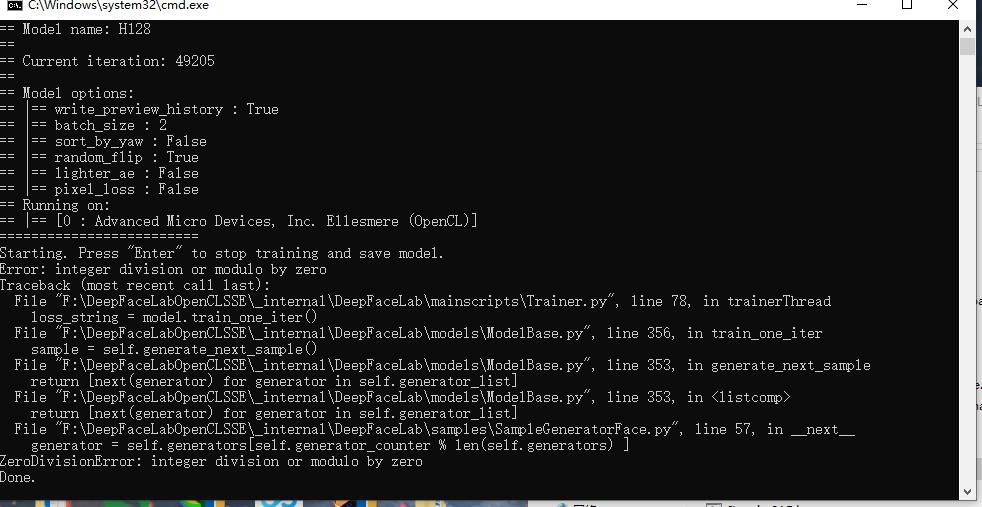DeepFaceLab别人训练好的model怎么使用
Posted
tags:
篇首语:本文由小常识网(cha138.com)小编为大家整理,主要介绍了DeepFaceLab别人训练好的model怎么使用相关的知识,希望对你有一定的参考价值。
点击序号6h128就马上弹出这个

tensorflow 1.0 学习:用别人训练好的模型来进行图像分类
谷歌在大型图像数据库ImageNet上训练好了一个Inception-v3模型,这个模型我们可以直接用来进来图像分类。
下载地址:https://storage.googleapis.com/download.tensorflow.org/models/inception_dec_2015.zip
下载完解压后,得到几个文件:
其中的classify_image_graph_def.pb 文件就是训练好的Inception-v3模型。
imagenet_synset_to_human_label_map.txt是类别文件。
随机找一张图片:如

对这张图片进行识别,看它属于什么类?
代码如下:先创建一个类NodeLookup来将softmax概率值映射到标签上。
然后创建一个函数create_graph()来读取模型。
最后读取图片进行分类识别:
# -*- coding: utf-8 -*- import tensorflow as tf import numpy as np import re import os model_dir=\'D:/tf/model/\' image=\'d:/cat.jpg\' #将类别ID转换为人类易读的标签 class NodeLookup(object): def __init__(self, label_lookup_path=None, uid_lookup_path=None): if not label_lookup_path: label_lookup_path = os.path.join( model_dir, \'imagenet_2012_challenge_label_map_proto.pbtxt\') if not uid_lookup_path: uid_lookup_path = os.path.join( model_dir, \'imagenet_synset_to_human_label_map.txt\') self.node_lookup = self.load(label_lookup_path, uid_lookup_path) def load(self, label_lookup_path, uid_lookup_path): if not tf.gfile.Exists(uid_lookup_path): tf.logging.fatal(\'File does not exist %s\', uid_lookup_path) if not tf.gfile.Exists(label_lookup_path): tf.logging.fatal(\'File does not exist %s\', label_lookup_path) # Loads mapping from string UID to human-readable string proto_as_ascii_lines = tf.gfile.GFile(uid_lookup_path).readlines() uid_to_human = {} p = re.compile(r\'[n\\d]*[ \\S,]*\') for line in proto_as_ascii_lines: parsed_items = p.findall(line) uid = parsed_items[0] human_string = parsed_items[2] uid_to_human[uid] = human_string # Loads mapping from string UID to integer node ID. node_id_to_uid = {} proto_as_ascii = tf.gfile.GFile(label_lookup_path).readlines() for line in proto_as_ascii: if line.startswith(\' target_class:\'): target_class = int(line.split(\': \')[1]) if line.startswith(\' target_class_string:\'): target_class_string = line.split(\': \')[1] node_id_to_uid[target_class] = target_class_string[1:-2] # Loads the final mapping of integer node ID to human-readable string node_id_to_name = {} for key, val in node_id_to_uid.items(): if val not in uid_to_human: tf.logging.fatal(\'Failed to locate: %s\', val) name = uid_to_human[val] node_id_to_name[key] = name return node_id_to_name def id_to_string(self, node_id): if node_id not in self.node_lookup: return \'\' return self.node_lookup[node_id] #读取训练好的Inception-v3模型来创建graph def create_graph(): with tf.gfile.FastGFile(os.path.join( model_dir, \'classify_image_graph_def.pb\'), \'rb\') as f: graph_def = tf.GraphDef() graph_def.ParseFromString(f.read()) tf.import_graph_def(graph_def, name=\'\') #读取图片 image_data = tf.gfile.FastGFile(image, \'rb\').read() #创建graph create_graph() sess=tf.Session() #Inception-v3模型的最后一层softmax的输出 softmax_tensor= sess.graph.get_tensor_by_name(\'softmax:0\') #输入图像数据,得到softmax概率值(一个shape=(1,1008)的向量) predictions = sess.run(softmax_tensor,{\'DecodeJpeg/contents:0\': image_data}) #(1,1008)->(1008,) predictions = np.squeeze(predictions) # ID --> English string label. node_lookup = NodeLookup() #取出前5个概率最大的值(top-5) top_5 = predictions.argsort()[-5:][::-1] for node_id in top_5: human_string = node_lookup.id_to_string(node_id) score = predictions[node_id] print(\'%s (score = %.5f)\' % (human_string, score)) sess.close()
最后输出:
tiger cat (score = 0.40316)
Egyptian cat (score = 0.21686)
tabby, tabby cat (score = 0.21348)
lynx, catamount (score = 0.01403)
Persian cat (score = 0.00394)
以上是关于DeepFaceLab别人训练好的model怎么使用的主要内容,如果未能解决你的问题,请参考以下文章